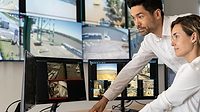Security Talk
Lessons learned from Trump assassination attempt
Former Secret Service agents share thoughts on the shooting at the Trump campaign rally in Pennsylvania.

SteveChristensen / E+ via Getty Images
I, like many other Americans, on Saturday, July 13 watched in shock as the news unfolded of the assassination attempt of Former President Donald Trump. Just about every news station and website showed on repeat the unbelievable video of President Trump being pulled off of the stage by Secret Service agents with blood trailing down his face before being escorted away from the scene.
As the story continued to develop, I reached out to some former Secret Service agents for their perspective on the incident. Here Fred Burton, Executive Director of Protective Intelligence at Ontic, a former police officer, former Diplomatic Security Service (DSS) special agent and New York Times best-selling author, and Travis Forrester, Director of Security and Emergency Management at Greenville County School District and former law enforcement and Secret Service Special Agent, share some of their initial thoughts after the news broke.
What are some key lessons security leaders can learn from the Secret Service’s response to the assassination attempt?
Burton: Like the assassination of John F. Kennedy in Dallas and Reverend Martin Luther King Jr. in Memphis, the attempt to kill President Donald J. Trump in Butler, Pennsylvania, will be studied by protectors for the next 50-years. The sniper attack showed how lone threat actors can exploit gaps in protection plans and operations, using “old school” tactics (like taking the high ground) that have been highly successful in the past. As the dust settles, it will be interesting to learn if the shooter had studied the past attacks on JFK or MLK. After a lifetime of protection, and countless investigations of attacks on VIPs, I would not be surprised in the least to learn that he had researched both. On a practical level, few, if any, corporate CEOs would face the same kind of sniper threat, but the attack is a vivid reminder of the importance of executive protection and special event advance work combined with emergency reaction plans, to include having secure routes of escape, holding rooms (safe havens) and medical resources on standby in the event of an emergency.
Forrester: Security leaders can draw several key lessons from the Secret Service’s response to the assassination attempt. They can evaluate their approach and try to incorporate the following:
- Comprehensive Risk Assessment: Conduct thorough and continuous risk assessments to identify potential vulnerabilities and threats from all angles, including surrounding buildings and structures.
- Interagency Collaboration: Enhance coordination and communication with local law enforcement, intelligence agencies, and private security entities to ensure a cohesive and comprehensive security approach.
- Rapid Response Protocols: Develop and practice rapid response protocols to quickly assess and respond to threats. This includes having predefined evacuation routes and secure locations for protected individuals.
- Training and Drills: Regularly conduct realistic training exercises and simulations to prepare security personnel for various scenarios. This should include both routine and extraordinary threat situations.
- Utilizing Technology: Leverage advanced technology for surveillance, threat detection and communication. Integrating real-time data and analytics can enhance situational awareness and response capabilities.
- Flexibility and Adaptability: Ensure that security plans are flexible and adaptable to changing circumstances. Personnel should be trained to make quick decisions and adapt to unexpected developments.
- Behavioral Analysis: Implement behavioral analysis techniques to identify potential threats based on patterns of behavior. This can help in preemptively identifying individuals who may pose a risk.
- Public Awareness and Engagement: Engage with the public and relevant stakeholders to promote awareness and vigilance. Encourage reporting of suspicious activities and ensure that there are clear channels for communication.
- Debriefing and Learning: Conduct detailed after-action reviews following any incident to identify what worked, what didn’t and why. Use these insights to update protocols and training programs.
- Resource Allocation: Ensure that resources are allocated effectively to cover all potential threat vectors. This includes investing in both human and technological resources to strengthen overall security measures.
- Visibility and Deterrence: Maintain a visible security presence to deter potential attackers. Visible measures can include both uniformed personnel and conspicuous surveillance systems.
- Psychological Preparedness: Prepare security personnel to handle high-stress situations through mental health support and resilience training. The ability to remain calm and focused under pressure is crucial.
What intelligence or indicators might lead to an elevated threat level for a former president?
Burton: History has shown that lone threat actors are the greatest threats to a President of the United States (POTUS). Continuously monitoring known threat actors is key in assessing an elevated threat to a former POTUS. In my experience with the U.S. Secret Service and State Department, protection assets and resources are threat driven, predicated upon protective intelligence threat assessments. Collecting and assessing adverse intelligence signals are key in understanding an elevated threat to a former POTUS. The tremendous benefit that the U.S. Secret Service has in this arena are the exceptional collection capabilities of our national security intelligence community (IC), combined with our intelligence liaison partners. In essence, the IC is always scanning the globe, proactively threat hunting. Threats are rapidly — in real-time — disseminated to the Secret Service. The system works well and is always on. But, terror threats aren’t usually the problem with the “formers”. In all probability, the IC will ferret that out; as evidenced by the recently disclosed alleged Iranian threat directed towards President Trump. It’s the lone threat actor with a rifle or handgun that seems to glide or hide under the radar. The unknowns are the ones that can haunt you and keeping track of the knowns is truly a full-time job, which is why the U.S. Secret Service has a dedicated unit to do so, known as the Protective Intelligence Division.
Forrester: An intelligence indicator is a piece of information or a sign that suggests a potential threat, risk, or significant event that requires attention. These indicators are often used in security and intelligence analysis to assess and anticipate threats, allowing for proactive measures to be taken. Intelligence indicators can be derived from various sources and can take many forms. Here are some examples:
- Specific Threats: Direct threats made against the former president through various channels, including social media, letters, emails, or phone calls.
- Credible Intelligence: Information from intelligence agencies indicating a credible plot or threat against the former president, such as plans uncovered during surveillance or interrogation of suspects.
- Behavioral Indicators: Reports of individuals exhibiting concerning behaviors, such as surveillance of the former president’s residence or frequenting locations the former president is known to visit.
- Terrorist Activities: Increased activities or communications among terrorist groups that mention the former president or indicate an interest in targeting them.
- Political or Social Unrest: Heightened political or social tensions, particularly those involving groups or movements opposed to the former president’s policies or actions while in office.
- International Developments: Changes in the international landscape, such as deteriorating relations with certain countries or emerging global conflicts that could increase the risk to a former president.
- Cyber Threats: Cyber intelligence indicating attempts to hack into the former president’s communications, personal data, or networks they are associated with.
- Public Events: The former president’s planned attendance at public events, especially those with large crowds or controversial topics, which might attract potential attackers.
- Associations with Controversial Figures: Engagements or associations with controversial figures or groups that might provoke adversaries to act against the former president.
- Changes in Routine: Sudden or significant changes in the former president’s routine or travel plans could make them more vulnerable to threats.
- Reports from Informants: Tips or reports from informants or confidential sources indicating a potential threat or suspicious activity.
- Incidents Involving Other High-Profile Individuals or Former/Current Presidents/Dignitaries: Attacks or plots against other high-profile individuals suggest a broader threat landscape.
- By monitoring and analyzing these and other indicators, the Secret Service and other protective agencies can assess the threat level and adjust security measures accordingly.
Looking for a reprint of this article?
From high-res PDFs to custom plaques, order your copy today!






